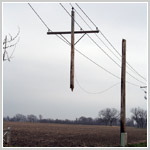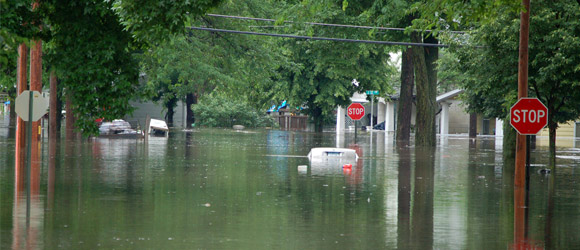 We may be screwing up Mother Nature, but she is getting back at us in her own way. And she knows we love electricity and the Internet.
We may be screwing up Mother Nature, but she is getting back at us in her own way. And she knows we love electricity and the Internet.
Though a lot of outages are man-made, there are a huge amount of power outages directly caused by nature every year. Causes include storms and hurricanes, earthquakes, flooding, and more often than not, animals too curious for their own best.
We had a look at some of the nature-made power outages so far in 2008, focusing mostly on the United States and North America, and how power outages have affected data centers and ISPs.
Outages caused by animals

Here is a small sample of what Mother Nature’s foot soldiers have accomplished so far this year.
- February 19: A bird caused a substation to catch fire and knocked out power to 6,400 customers (a 2 ½-mile radius) in downtown St. Augustine, Florida.
- April 5: A big rat managed to short-circuit a substation and cut off power to the central train station in Stockholm, Sweden. (Ok, we’ve focused mostly on outages in North America, but since Pingdom is Swedish we had to include one from here as well. 🙂 )
- May 30: 2,400 households and businesses in Greenville, North Carolina, lost power after a squirrel got into a circuit switcher at a substation.
- June 5: 3,100 customers in Statesville, North Carolina, were left without power after a blacksnake had crawled into an electrical substation.
- September 25: The Austin-Bergman International Airport in Texas lost power after a snake somehow managed to cut power to the two main circuits that fed the airport.
- October 6: A goose managed to blow a transformer, cutting power to more than 4,000 customers in Reno, Nevada.
- October 13: An opossum got into a substation and caused a blackout affecting 5,500 power customers in Troy and Lansingburg, New York.
- October 15: A raccoon chewed into equipment and damaged a transformer, knocking out power to 8,000 customers in Harrisonburg, Virginia.
Stubborn and curious squirrels are actually a well-known plague for power companies. For plenty of other examples, read this post dedicated 100% to outages caused by squirrels.
And as if this avalanche of animals weren’t enough, Mother Nature resorts to other tactics as well. Cue…
Outages caused by storms

While an animal will hurt one single location, usually a substation, a storm can cause much more widespread damage.
- January 4: 1.2 million customers in the California Bay Area lost power when a storm with winds up to 100 mph (44 meters/s) hit the region. It took almost a week before all power had been restored.
- March 4: An ice storm in Ohio left up to 100,000 customers without power, spread over various regions where it hit the hardest.
- June 4: About 500,000 homes and businesses were left without power after a violent thunderstorm struck the Washington area in District of Columbia. Even two days later, 50,000 were still without power.
- July 21: Thunderstorms and high winds cut power to 18,000 customers in portions of central Illinois.
- August 4: A series of thunderstorms left 479,000 Chicago power customers in the dark.
- September 13: Then of course there was Hurricane Ike in September, the third most destructive hurricane to ever hit the United States. Between September 13 and September 15, it caused around 7.5 million to lose power, all the way from Texas to New York.
(And here’s a little Twilight Zone moment: What’s up with so much happening on the 4th?)
Outages caused by floodings

Flooding is often caused by rain storms, but can also be caused by for example melting snow, as you can see in the example below, so we gave it its own category.
- March 5: Melting snow and heavy rains caused severe power outages and blocked roads in the middle of the presidential primary election in Ohio.
(If that includes March 4, this is getting spooky… 🙂 )
Outages caused by earthquakes

From what we could find by searching the news, earthquakes haven’t been so much of a problem in North America so far in 2008, though many other countries have not been so lucky. Here are some smaller incidents from the United States:
- April 18: A 5.2 magnitude earthquake shook southern Illinois and eastern Missouri and left approximately 1,000 without power.
- July 29: A 5.4 magnitude earthquake hit just outside Los Angeles, California, and left 5,000 customers without power.
Website downtime and lost Internet connectivity
It’s important to remember that power outages have secondary effects that can cause outages in many other services. If telecoms and ISPs are affected, this can cause significant outages for websites hosted in that area, and of course households without power can’t exactly access the Internet.
Data centers normally have backup power, but things don’t always work as planned. Here are some examples of data center and ISP outages caused by power failures so far this year:
- In January, the GNAX data center suffered technical problems for hours following a brief loss of power.
- In June, Amazon had a power outage at one of its data centers, which affected parts of its EC2 utility computing platform.
- In July, a power outage at a Colt data center caused the travel website Lastminute.com to be offline for close to a day.
- Also in July, a power outage at Rackspace’s Dallas data center caused problems for among others 37signals and Syncplicity.
- Another July incident, a Peer 1 data center in Vancouver suffered from a major power outage that knocked out, among others, dating site Plenty of Fish and the web hosting provider Bravenet.
- In September, Hurricane Ike caused a lot of network outages on the Internet. At one point around 100 networks were damaged.
- And this last Monday, several of OpenSUSE’s Web services went offline due to a power outage at Novell.
Those were just a few examples of what has happened to far in 2008. Though these specific data center outages weren’t necessarily caused by nature, it does prove our point that even though backup power solutions are in place, these will sometimes not work as planned.
A few final words
In the cases of severe storms, hurricanes and earthquakes, there are often more immediate problems to worry about than the state of your Internet connectivity. However, considering what Pingdom is about (uptime monitoring) and what we usually write about in this blog, we focused on the effect these power outages have on the Internet infrastructure.
Sounds to us like people planning locations for new data centers might want to have a look at the local news to see how common these “nature attacks” on electricity are in the region. We have actually written something related to that before: Where NOT to place your servers according to Mother Nature.
Photos:
Raccoon by Michael Scheltgren.
Squirrel by Gilles Gonthier.
Goose by David Evers.
Earthquake library by the San Jose Library.
Thunderstorm by Danrandom.
Storm Cross by Kelly Poull.
Flooding by the U.S. Geological Survey.
Snake by Benny Mazur.


























